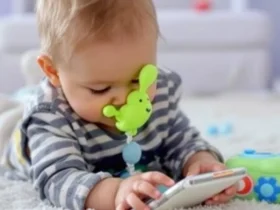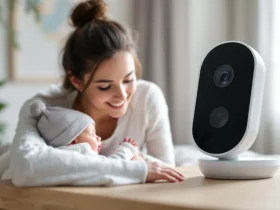Smart Baby Monitors and Sleep Trackers

Futuristic Gadgets That Show Parenting Will Never Be the Same – The advent of sophisticated smart baby monitors represents a significant leap forward in parental care, moving beyond basic audio and video surveillance to provide comprehensive insights into a baby’s health and sleep patterns. This technology promises to alleviate parental anxiety, improve sleep quality for both parents and child, and ultimately contribute to a more harmonious family life.
These advancements are not merely convenient; they offer data-driven solutions to common challenges faced by new parents.
Futuristic smart baby monitors integrate advanced sensors and artificial intelligence to offer capabilities far exceeding their predecessors. High-resolution cameras with night vision provide crystal-clear images, while sophisticated microphones pick up even the faintest sounds. Beyond the basics, however, these devices employ AI-powered cry analysis to differentiate between various types of cries, potentially indicating hunger, discomfort, or illness.
Sleep tracking features monitor sleep duration, movement, and breathing patterns, providing parents with valuable data to understand their baby’s sleep cycles and identify potential sleep disturbances. Some models even incorporate biometric sensors to monitor heart rate, respiration rate, and oxygen saturation, offering an early warning system for potential health concerns.
This continuous monitoring significantly reduces parental anxiety, allowing for more restful sleep and a greater sense of security.
Smart Monitor Feature Comparison
The following table compares three hypothetical smart baby monitors, each offering a different range of features and price points. These represent potential market offerings, showcasing the diversity of technology available.
| Feature | Monitor A (Budget-Friendly) | Monitor B (Mid-Range) | Monitor C (Premium) |
|---|---|---|---|
| High-Resolution Video | Yes | Yes (with night vision) | Yes (with pan/tilt/zoom) |
| Audio Monitoring | Yes | Yes (with sound level detection) | Yes (with AI-powered cry analysis) |
| Sleep Pattern Tracking | Basic sleep/wake detection | Sleep cycle analysis, movement tracking | Sleep cycle analysis, movement tracking, biometric data (heart rate, respiration) |
| Biometric Data Monitoring | No | No | Heart rate, respiration rate, oxygen saturation |
| Smart Home Integration | Limited | Integration with smart lighting | Integration with smart lighting, smart thermostat, white noise machine |
| Predictive Analytics | No | Basic sleep pattern prediction | Advanced sleep pattern prediction, potential health risk alerts |
Smart Home Integration for Optimized Sleep, Futuristic Gadgets That Show Parenting Will Never Be the Same
The data collected by smart baby monitors can be seamlessly integrated with other smart home devices to create a more optimized sleep environment for both baby and parents. For instance, sleep tracking data can trigger automated adjustments to the smart home environment.
If the monitor detects that the baby is restless, the smart lighting system could automatically dim the lights, while a smart thermostat could subtly adjust the room temperature to a more comfortable level. Similarly, a white noise machine could be activated to mask disruptive sounds.
This integrated approach creates a more responsive and supportive sleep environment, reducing parental stress and improving the overall quality of sleep for both the baby and caregivers. For example, if the baby’s heart rate elevates significantly during sleep, the system could alert the parents and automatically adjust the room temperature, simulating a more soothing environment based on pre-programmed parameters or learned preferences.
Advanced Educational Toys and Learning Platforms
The convergence of artificial intelligence, augmented reality (AR), and virtual reality (VR) is poised to revolutionize how children learn and play, ushering in an era of personalized and highly engaging educational experiences. These technologies offer unprecedented opportunities to cater to individual learning styles and paces, fostering a deeper understanding and a genuine love of learning from a young age.
This represents a significant shift from traditional, one-size-fits-all educational approaches.The integration of AR and VR technologies promises to transform children’s education and play into immersive and interactive adventures. AR overlays digital information onto the real world, while VR creates entirely simulated environments.
Both technologies can significantly enhance engagement and comprehension, particularly for subjects that traditionally struggle to capture young minds. By making learning fun and experiential, these technologies aim to bridge the gap between passive absorption and active participation.
Augmented Reality Math Game for Preschoolers
This interactive AR game, tentatively titled “Number Explorers,” uses a child’s tablet or smartphone to transform their play area into a vibrant, explorative landscape. The game uses a combination of object recognition and location-based tracking. The child points their device at real-world objects – building blocks, toys, even fruits – and the AR overlay transforms these objects into interactive mathematical elements.
For example, a red building block might become a “+2” unit, a blue one a “-1” unit. The game presents simple addition and subtraction problems visually, requiring the child to strategically combine the objects to reach a target number. Success is rewarded with animated celebrations and virtual rewards, further motivating the child.
Learning objectives include mastering basic addition and subtraction up to 10, understanding number relationships, and developing problem-solving skills. The game adapts to the child’s performance, adjusting the difficulty level based on their success rate, ensuring a continuous challenge and sustained engagement.
A progress tracker shows parents the child’s achievements and areas needing further attention. This data-driven approach ensures personalized learning and facilitates targeted parental support.
Personalized Learning Platforms
Personalized learning platforms leverage AI algorithms to analyze a child’s learning patterns, identifying strengths and weaknesses in real-time. These platforms dynamically adjust the curriculum, pacing, and teaching methods to best suit the individual child. For example, a child who excels in visual learning might receive more diagram-based exercises, while a child who prefers hands-on activities might be presented with interactive simulations or physical puzzles integrated with the digital platform.
Khan Academy Kids, for instance, offers a personalized learning experience with adaptive assessments and customized learning paths. Such platforms also provide detailed progress reports to parents, allowing them to monitor their child’s development and provide targeted support. By offering customized learning experiences, these platforms aim to maximize each child’s potential and foster a lifelong love of learning.
This approach contrasts sharply with traditional methods, which often struggle to cater to the diverse learning styles and paces present in any classroom.
Robotics and Automation in Childcare

The burgeoning field of robotics is poised to revolutionize childcare, offering solutions to persistent challenges like staffing shortages and the need for personalized care. While the integration of robots into this sensitive sector raises ethical and societal concerns, the potential benefits for both children and caregivers are undeniable.
This section explores the emerging role of robotic assistants in childcare, examining both the advantages and drawbacks of increased automation.Robotic Assistants in Childcare TasksRobotic assistants are being developed to handle a range of childcare tasks, moving beyond simple monitoring to active participation in a child’s daily routine.
These robots are designed to be safe, interactive, and capable of adapting to individual children’s needs. For example, specialized robots could assist with feeding, ensuring proper portion sizes and dietary requirements are met. Others could aid in bathing, providing a gentle and consistent experience.
Furthermore, robots equipped with advanced AI can engage children in playful interactions, offering educational games and storytelling, thus supplementing human interaction rather than replacing it.Societal Impact of Automation in ChildcareThe widespread adoption of robotic assistants in childcare will undoubtedly have a profound societal impact.
On the one hand, it could alleviate the burden on caregivers, freeing up time for more personalized attention and interaction. This could also lead to a more affordable and accessible childcare system, particularly in areas with staffing shortages.
However, concerns remain about the potential displacement of human caregivers, the emotional impact on children of increased reliance on technology, and the need for robust safety and ethical guidelines governing the design and deployment of these robots. The long-term economic effects, including the creation of new jobs in robotics engineering and maintenance, also need careful consideration.A Daycare Setting with Robotic AssistantsImagine a daycare center where robots seamlessly integrate into the daily routine.
Small, child-friendly robots equipped with cameras and sensors assist teachers with tasks like monitoring children’s activities and alerting caregivers to potential hazards. Larger, more robust robots assist with tasks like moving cribs, cleaning play areas, and even preparing simple meals.
These robots are programmed to recognize individual children and respond appropriately to their cues. For example, a robot might offer a comforting hug to a child who is upset or engage a child in a game of peek-a-boo.
The human caregivers remain central to the operation, utilizing the robots as tools to enhance their efficiency and effectiveness, allowing them to focus on fostering emotional connections and providing individualized care. This collaborative approach ensures that the human element remains at the core of childcare, while leveraging technology to enhance its quality and accessibility.
Predictive Analytics and Child Development

The burgeoning field of predictive analytics is poised to revolutionize childcare, offering the potential to identify developmental delays and challenges earlier than ever before. By analyzing vast datasets encompassing genetic information, behavioral patterns, and environmental factors, algorithms can predict the likelihood of a child experiencing difficulties in areas such as language acquisition, motor skills development, or social-emotional growth.
This proactive approach allows for timely interventions, potentially mitigating long-term negative consequences.Predictive analytics leverages machine learning models trained on large datasets of children’s developmental trajectories. These models identify patterns and correlations that might be missed by human observation alone.
For instance, subtle variations in a child’s responses to interactive games or delays in reaching developmental milestones can be flagged as potential indicators of future challenges. This data-driven approach allows for personalized intervention strategies tailored to each child’s unique needs and risk profile.
Early Intervention Program Enhancement Through Data-Driven Insights
Data-driven insights from predictive analytics can significantly enhance early intervention programs. By identifying at-risk children early, resources can be allocated more efficiently, focusing on those who need them most. For example, a child predicted to have a high likelihood of speech delay could receive targeted speech therapy interventions before significant language deficits develop.
This proactive approach is significantly more cost-effective and impactful than reactive interventions implemented after significant delays have already occurred. Furthermore, predictive models can help optimize the design and delivery of early intervention programs, ensuring that they are tailored to specific needs and effectively address identified risks.
A study by the University of California, San Francisco, for instance, demonstrated how a predictive model successfully identified children at risk for autism spectrum disorder, leading to earlier diagnosis and intervention, improving developmental outcomes.
Privacy and Ethical Considerations in Predictive Analytics for Child Development
The application of predictive analytics in child development raises important privacy and ethical concerns. The collection and analysis of sensitive personal data, including genetic information and behavioral patterns, necessitate robust data protection measures to prevent unauthorized access and misuse. Transparency regarding data collection practices and algorithmic decision-making processes is crucial to build public trust.
Furthermore, the potential for bias in algorithms trained on biased datasets must be carefully addressed. If the training data reflects existing societal inequalities, the resulting predictions may perpetuate and even exacerbate those inequalities. For example, an algorithm trained primarily on data from affluent families might inaccurately predict developmental delays in children from disadvantaged backgrounds, leading to missed opportunities for intervention.
Establishing clear ethical guidelines and regulatory frameworks is essential to ensure responsible and equitable use of predictive analytics in this sensitive domain. The potential for stigmatization based on predictive risk assessments also necessitates careful consideration and robust safeguards to protect children’s well-being and avoid labeling children based on probabilistic predictions.
Final Thoughts

The integration of futuristic gadgets into parenting is undeniably reshaping the landscape of childcare. While offering unparalleled opportunities for enhanced safety, personalized learning, and improved parental well-being, the ethical considerations and potential societal impacts cannot be overlooked. A balanced approach, one that leverages technological advancements responsibly and ethically, is crucial to ensure that these innovations serve to empower parents and foster the healthy development of children, not replace the irreplaceable human element of nurturing and care.
The future of parenting is undeniably intertwined with technology, demanding a careful and thoughtful navigation of its transformative potential.
Expert Answers: Futuristic Gadgets That Show Parenting Will Never Be The Same
What are the privacy concerns surrounding AI-powered parenting assistants?
Data privacy is paramount. Concerns exist regarding the collection and use of sensitive child data by AI assistants. Robust data encryption, secure storage, and transparent data usage policies are crucial to mitigate these risks.
How can parents ensure the safety of their children when using smart devices?
Prioritize reputable brands with strong security features. Regularly update software, use strong passwords, and be mindful of the data permissions granted to apps. Parental controls and monitoring tools should also be utilized where available.
Are these technologies accessible to all parents?
The cost of many of these technologies can be prohibitive, creating a potential disparity in access. Affordability and equitable distribution remain significant challenges.
What is the potential for over-reliance on technology in parenting?
Over-reliance can lead to a diminished role of human interaction and intuition in childcare. Maintaining a balance between technological assistance and direct parental involvement is crucial for healthy child development.










Leave a Reply
View Comments